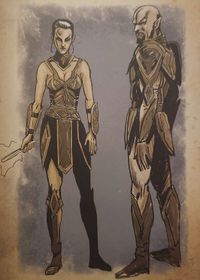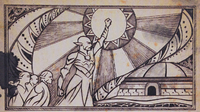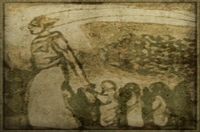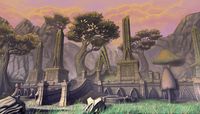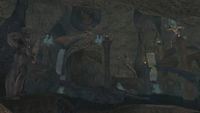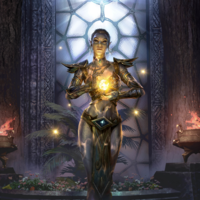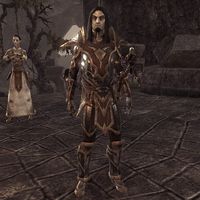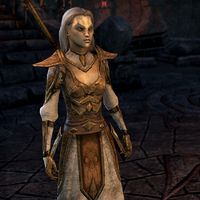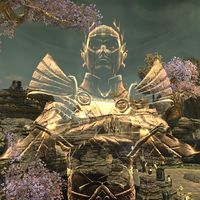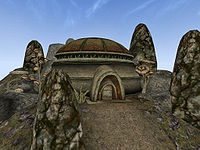Lore:Chimer
- "Boethiah showed them the lies of the et'Ada, the Aedra, and told them Trinimac was the biggest liar of all, saying all this with Trinimac's voice! Boethiah told the mass before him the Tri-Angled Truth. He showed them, with Mephala, the rules of Psijic Endeavor. He taught them how to build Houses, and what items they needed to bury in the Corners. He demonstrated the right way to wear their skin. He performed the way to walk to achieve an Exodus. Then Boethiah relieved himself of Trinimac right there on the ground before them to prove all the things he said were the truth. It was easy then for his new people to become the Changed Ones." — The Changed Ones
The Chimer (literally, the People of the North),[1] also called the Changed Folk,[2] Velothi, Changed Ones,[3] or the archaic Maliache[UOL 1] were the Aldmeri tribes of dissidents who abandoned the ways of Summerset Isle and embarked on a great exodus to Morrowind.[4][5] They followed the prophet Veloth, who spoke to them on behalf of Boethiah, Prince of Plots, and two other "Good Daedra". The teachings of Veloth and the Daedra spawned a new culture on Tamriel and a new people, sparking the period of the High Velothi culture. They were dynamic, ambitious, long-lived Elven clans devoted to fundamentalist ancestor worship.[6] In appearance they had a dull golden skintone with bright yellow eyes.[7] Almalexia of the Tribunal apparently maintained her appearance as a Chimer (as did Vivec, partially) despite the Curse which changed the Chimer into the Dunmer.[8]
History[edit]
The history of the Chimer begins with the Velothi dissident movement in the Summerset Isle. Some sources seem to differ on when exactly this happened. Some say it took place in the Late Middle Merethic Era,[6] and others trace it back to the Dawn Era.[9] One source says it took place before the shattering of Lorkhan,[10] and another says that it was after Topal the Pilot and others had explored mainland Tamriel.[11]
The Exodus[edit]
Trinimac, strongest of the Altmeri ancestor spirits, fought enemies of Altmeri society both without and within. As such, Trinimac and his followers became engaged in trying to halt the Velothi dissident movement.[9] Boethiah, the "Devourer of Trinimac",[12] took exception to the "lies" Trinimac had been spreading about Lorkhan.[5] He tricked Trinimac, ate him, assumed his form, and the dung he excreted became Malacath.[2] The followers of Boethiah and Trinimac rubbed this excrement on themselves to change their skins.[13] It was the followers of Boethiah (i.e. the followers of Veloth) who became the Chimer. Boethiah and Mephala told the masses about the Tri-Angled Truth, the rules of Psijic Endeavor, how to build Houses, and demonstrated the "right way to wear their skin".[5] Mephala took a third of the followers in attendance and took them to the southeast as she alone did not fear the Hist, where they became the Cantemiric Velothi. Azura took a third and took them to the star-wounded east, and Boethiah took the final third to a land that drifted into the ocean and would have stories to tell in times yet to come.[14] Altmeri propaganda portrayed this as a lesson on the dangers of Velothi influence,[2] while Velothi propaganda regarded Trinimac's transformation as punishment for attempting to interfere with their exodus. Malacath himself derided this narrative as being too "literal-minded" (implying the essence of the story, while metaphorical, is somewhat accurate).[15]
High Velothi Culture[edit]
Vivec: "Making sure the other dies before you."
So, the Chimer departed. They credited the Good Daedra with teaching them the principles of their new way of life.[5] Worship of Aedra such as Akatosh, disappeared from their legends.[2] They typically associate most of the things they learned with Boethiah, but Mephala is credited with teaching them the ways of evasion and assassination, and Azura with teaching them how to be different from the Altmer.[2][13] The Good Daedra also warned the Chimer of the "Bad Daedra", such as Molag Bal, who sought to spoil Chimeri "purity".[2] In their new homeland, which they called Resdayn, they quickly came into conflict with the Nedes, Orcs and the Dwemer.[9][16] With the Dwemer, especially, territorial disputes combined with religious animosity created a great deal of conflict.[16] Historians blame the Chimer for provoking these conflicts.[6] Regardless of who started it, the Chimer were generally on the losing end of these conflicts. Though they wielded great magic and had fine warriors, the Chimer were a small group, and the Dwemer had an incredible technological advantage.[2][13] It was around this time that kwama were domesticated and the Chimer made strides in the agrarian development of their early settlements.[17]
The Late Merethic Era saw the precipitous decline of Velothi culture. Some Chimer settled in villages near declining and abandoned ancient Velothi towers. During this period, Velothi high culture disappeared on the island of Vvardenfell. The earliest Dwemer Freehold colonies date from this period, suggesting they were created to secure Dwemeri lands from Chimeri incursions. Degenerate Velothi devolved into tribal cultures which, in time, evolved into the modern Great Houses of Morrowind, or persisted as the barbarian Ashlanders.[6] There was some cultural interchange with the other races as well, such as the Dwemeri influence on Chimer garbs in the latter half of the Merethic Era.[17]
The Curse[edit]
— Vivec
Around 1E 240,[18] the Nords under High King Vrage conquered all of Morrowind, making it part of the First Empire of the Nords.[19] The Nords' use of the thu'um against the Chimer made them practically unstoppable,[20] although some blame the god Sai for favoring the Nords.[21] They would remain under the Nords' heel until around 1E 416, when they joined forces with the Dwemer to repulse the invaders.[22] The friendship between Chimer leader Nerevar and the Dwemer leader Dumac forged the basis for an alliance between the races under the First Council, leading to almost three hundred years of peace. Eventually, a dispute over the Dwemer's discovery, the Heart of Lorkhan, led to the War of the First Council, which culminated in the Battle of Red Mountain. A few years later, the betrayal of an oath by the Tribunal led to the Curse:[1] the Chimer's skin turned black as ash, and their eyes became red. The Chimer ceased to exist, and the days of the Dunmer began.[23][24] Some Dunmer don't consider the darkening of their skin to be a curse, rather they see their sober complexion as a gift to mark the ascent of the Tribunal.[25]
Dunmer theology speaks of an island occupied by Chimer that was separated from Tamriel and drifted into the sea, where it would remain untouched and have many stories to tell in times yet to come.[14] Dubious Imperial records speak of a tribal remnant of Chimer called the Chimeri-quey inhabiting Cathnoquey in the Third Era, composed of fisherfolk who live on the coastlines in grand flotilla-townships of advanced design.[UOL 2]
Though Sotha Sil was one of the few who could resist Azura's curse, he chose to embrace the new Dunmer appearance.[26] Eventually the Dunmer stopped worshipping the Tribunal following the Red Year, but despite their return to worship of the Good Daedra, it is thought that they were not changed back into Chimer by Azura because of Boethiah's instructions to become the "color of bruise" and show the most vital part of being a people of the exodus: pain.[UOL 3]
Gallery[edit]
Notes[edit]
- The term "Velothi" can be used to refer to any followers of Veloth.[27][28] However, by the Third Era, it was also often used to refer to former Ashlanders who had abandoned their nomadic lives in favor of the Great Houses of Morrowind.[29]
- Sources sometimes refer to the Chimer as the Dunmer in events dated before the Battle of Red Mountain, before the Dunmer actually existed.[30][19][31][32]
- One of the masterpieces of the great artist Cherim depicted Veloth leading the Chimer into Morrowind.[33]
- Malacath's moon symbol represents the "Curse of Shadow" in House of Troubles imagery, suggesting it is the Dunmer's name for their skin change and that they associate Malacath with it.[UOL 4]
- King Helseth wore an ancient crown of the Chimer that appears as five points curving inward like blades, supporting one in the middle. What it symbolized in elder days was debatable, but in the modern day, it meant "Five Houses Under One King".[UOL 5]
See Also[edit]
- Chimer Names
- For a list of notable Chimer, see here.
- For game-specific information, see the Elder Scrolls Online article.
Books[edit]
- The 36 Lessons of Vivec by Vivec — Words of wisdom relating to Vivec
- The Battle of Red Mountain by Vivec — The story of the Battle of Red Mountain and the Nerevarine Prophecies from Vivec's perspective
- The Changed Ones — Story of how Boethiah refuted Trinimac
- Chimarvamidium by Marobar Sul — Book 6 of a series of fictional stories about the Dwemer
- Nerevar at Red Mountain by the Tribunal Temple — A scholarly description of the events surrounding the Battle at Red Mountain and its aftermath
- Pocket Guide to the Empire, 3rd Edition: All the Eras of Man, A Comprehensive History of our History by the Imperial Geographical Society
- Pocket Guide to the Empire, 3rd Edition: The Temple: Morrowind by the Imperial Geographical Society
- The True Nature of Orcs — Book detailing the Orsimer race and their origin
- Varieties of Faith... by Brother Mikhael Karkuxor of the Imperial College — An expansive list of the pantheons and associated divine spirits of Tamriel's dominant cultures
References[edit]
- ^ a b Dialogue of Savants in Morrowind
- ^ a b c d e f g Varieties of Faith... — Brother Mikhael Karkuxor of the Imperial College
- ^ The Annotated Anuad
- ^ Dialogue in Morrowind
- ^ a b c d The Changed Ones
- ^ a b c d Before the Ages of Man — Aicantar of Shimerene
- ^ Appearance of Chimer characters in ESO
- ^ Events of Morrowind
- ^ a b c The True Nature of Orcs
- ^ The Monomyth
- ^ Father of the Niben — Florin Jaliil
- ^ Dialogue of Boethiah cultists in Skyrim
- ^ a b c The Anticipations — Anonymous
- ^ a b From Exile to Exodus — Tarvyn Aram
- ^ Lord of Souls — Greg Keyes
- ^ a b Pocket Guide to the Empire, 3rd Edition: The Temple: Morrowind — Imperial Geographical Society, 3E 432
- ^ a b Nevena's Diary — Nevena Nirith
- ^ King Edward, Part X — Anonymous
- ^ a b Pocket Guide to the Empire, 1st Edition: Skyrim — Imperial Geographical Society, 2E 864
- ^ The Art of War Magic — Zurin Arctus, with Commentary By Other Learned Masters
- ^ King Edward
- ^ Pocket Guide to the Empire, 3rd Edition: All the Eras of Man, A Comprehensive History of our History — Imperial Geographical Society, 3E 432
- ^ The Battle of Red Mountain — Vivec
- ^ Nerevar at Red Mountain — the Tribunal Temple
- ^ Sorcerer Vunal's dialogue in ESO
- ^ Divayth Fyr's dialogue in ESO: Clockwork City
- ^ Sinnammu Mirpal's dialogue in Morrowind
- ^ Nibani Maesa's dialogue in Morrowind
- ^ Generic dialogue regarding the topic of Ashlander Culture in Morrowind
- ^ Pocket Guide to the Empire, 1st Edition: Morrowind — Imperial Geographical Society, 2E 864
- ^ The War of the First Council — Agrippa Fundilius
- ^ Saint Nerevar
- ^ Cherim's Heart of Anequina — Livillus Perus, Professor at the Imperial University
Note: The following references are considered to be unofficial sources. They are included to round off this article and may not be authoritative or conclusive.
| |||||||||||||||||||||||||||||||||||||||||||

